
Search results can turn up lots of interesting-looking pages, but efficient web learning means spending most of your time looking at the high-quality sites.
People who know how to learn from the internet tend to be highly discriminating in their web site selection. They are good at evaluating sources.
How can you tell which sites are best?
Can strategies for evaluating sources be readily learned, or is the appreciation of good information more akin to appreciating good wines, taking years to develop?
Jennifer Wiley and her colleagues tested the potential benefits of a one-hour training session on evaluating sources. The researchers wanted to know if students could learn this specific set of critical thinking skills effectively and efficiently.
The web learners in Wiley’s experimental program were given a set of questions and criteria to ask themselves to judge the credibility and usefulness of online sites. The main elements of instruction are reported in Wiley’s article on source evaluation (Appendix B):
Who is the author? How reliable is the information? How well does the site explain the information?
And unpacking the overall questions further:
- Who is the author?
- Can you figure out who the author is?
- Is the person who is providing the information someone who is knowledgeable about the topic?
- What is their motivation?
- How reliable is the information?
- Is the information based on scientific evidence?
- Is there similar information given across reliable sources?
- How well does the site explain the information?
- Do you understand how the process works based on the information provided?
- Does the explanation fit together with your prior scientific knowledge or with information from other reliable sites?
The students practiced using the questions to evaluate web sites that appeared in results pages from search on a dietary issue, “Is the Atkins low-carbohydrate diet healthy or harmful?”
Their task was not to weigh in on Atkins. The intent was to practice evaluating sources. The students used the questions they were given as a guide to rank the reliability of the web sites. Finally, they compared their answers with those of experts who had rated the same sites. This gave the student web learners a way to see how well they could tell which were the most and least credible sources, and adjust the criteria they were using.
In any kind of training like this, what we really want to know is whether the cognitive strategies can still be used for any new topics.
The goal here isn’t to get good at judging diets, but rather to improve critical thinking skills for evaluating sources regardless of the topic.
The ability to transfer what you just learned to a new situation is often difficult, and a common failure point in developing higher-order thinking skills.
Wiley tested the transfer of skill in website source evaluation by having participants come back to the lab a week after their training session. When they returned, the web learners found themselves using the web to study about the causes of volcanic eruptions (rather than diets).
They spent the next few minutes recovering from the disappointment on realizing they were to spend their time thinking about rocks rather than food. Then, they got busy with their web research.
It turned out that the students had internalized their thinking skills for evaluating sources quite well. They readily transferred them to the new topic.
Wiley and colleagues reported that the students who engaged in the training discriminated more between the reliable and unreliable websites than those in a control condition.
Web learners who participated in the training for evaluating sources also learned the topic material more deeply. Specifically, they gained a more complex understanding of the causal forces involved in volcanic eruptions.
Image credits: spree2010

Wow! After all I got a webpage from where I know how to actually get
valuable facts regarding my study and knowledge.